|
|
|
Dr. Ramon Carrillo had a vision: he believed that Argentina needed 20,000
professional nurses to overcome the serious health problems which afflicted
its population. He set his priorities based on the areas where he felt
Argentina lagged behind the developed world: 1) Infant deaths; 2) Tuberculosis;
3) Venereal disease; 4) Mental Health; 5) Epidemics; 6) Helping People
with Disabilities; 7) Increasing Life Span. First, he wanted to cure the
sick, then prevent the illness, and finally attack the socioeconomic factors
which caused the illness (lack of proper nutrition, unsafe working conditions,
ignorance of basic hygiene). His plan, titled "Plan Analítico de Salud
Pública," published in 1947 by the Secretaria de Salud Pública de la Nación,
dealt with causes, consequences, and effects. Professional nurses were
indispensable to its success.
Dr. Carrillo found an intelligent and willing collaborator in Teresa Adelina
Fiora, secretary to the Nursing School in the Peralta Ramos Hospital,
who suggested that all existing nursing schools be centralized and their
course of study updated.
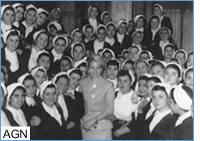 In
less than a year, Fiora, supported by a team of doctors which included
Jorge Albertelli, Evita's doctor, had organized the Eva Peron School of
Nursing. In
less than a year, Fiora, supported by a team of doctors which included
Jorge Albertelli, Evita's doctor, had organized the Eva Peron School of
Nursing.
The course lasted two years. During the first year the nurses studied
Hygiene and Epidemiology; Anatomy and Physiology; Semiology; General Pathology
and Therapeutics; national Defense and Public Disasters. Second year courses
included First Aid; Infirmary - medical and surgical; Obstetrics; Gynecology;
Pediatrics; Dietetics; and Social Medicine.
Post graduate studies took two more years to complete and included residence
training a the Hospital Presidente Peron in Avellaneda, and other new
Fundacion hospitals in Lanus, San Martin, and Ramos Mejia, where nurses
specialized in different areas including laboratory technology, neonatology
and psychiatry.
When the Society of Beneficence ran the nursing schools, nurses were little
more than glorified servants with no real medical training. Evita envisioned
professionals who could work in remote areas, without doctors if necessary.
Nurses were taught to drive the different vehicles of the Fundacion Eva
Peron: ambulances, hospital ambulances (each one with ten beds and an
operating theater); ambulances equipped for emergency surgery; jeeps;
motorcycles; and vehicles used for transporting doctors and nurses.
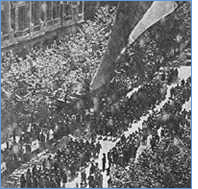 The
Nursing School, la Escuela de Enfermeras, was completely integrated into
the Fundacion by September of 1950 and by 1951 had graduated more that
5,000 nurses. The
Nursing School, la Escuela de Enfermeras, was completely integrated into
the Fundacion by September of 1950 and by 1951 had graduated more that
5,000 nurses.
The only limitation for entry into the Nursing School was that of age:
women had to be between the ages of 18 - 34. Students who could not afford
the fees were subsidized by the Fundacion Eva Peron. Adelina Fiora remembers,
"Many [of the candidates] came from very humble homes and had no concept
of the discipline necessary for the studies they would undertake. I thought
one way to teach them to be organized was to have them raise and lower
the flag in the patio of the school, just as is done in our primary and
secondary schools. That way they went into their classes together and
ready to work."
Delia Maldonado - one of the Fundacion nurses - also remembers the discipline
and the care that was to be taken of their sky blue uniforms. "Discipline
was something that was inculcated into us. A nurse must always be calm,
no matter what the problem or situation; otherwise, she cannot offer her
help in the way she should. This discipline also manifested itself in
the respect we showed the patient. The first lesson we learned was to
greet the patient. Greet him and ask him how he felt. We had to accompany
the patient because 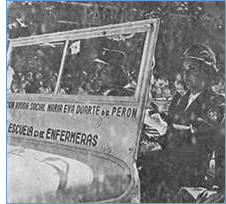 when
you check into a hospital, no matter how good the care or luxurious the
surroundings, you always feel a sensation of abandonment, We had to offer
confidence and assurance that all would be well. We never turned on the
lights of the ward [abruptly] or awakened patients by clapping our hands
or shouting [as was done when nurses were trained by the Society of Beneficence].
Also, we always had to wear our uniform and it was our responsibility
to keep it clean and neat. when
you check into a hospital, no matter how good the care or luxurious the
surroundings, you always feel a sensation of abandonment, We had to offer
confidence and assurance that all would be well. We never turned on the
lights of the ward [abruptly] or awakened patients by clapping our hands
or shouting [as was done when nurses were trained by the Society of Beneficence].
Also, we always had to wear our uniform and it was our responsibility
to keep it clean and neat.
Nurses did not just work in hospitals. Together with the Armed Forces,
they also participated in antimalarial and anti "mal de changas" campaigns.
They accompanied doctors and social workers all over the world to offer
solidarity and specialized treatment when disaster struck. Some even gave
their lives in services to humanity. In 1949, a terrible earthquake struck
Ecuador. Medical personnel from the Fundacion Eva Peron flew in a Fundacion
plane to the neighboring country to help. On its return to Buenos Aires
the plane crashed. Among those killed were two nurses, Amanda Allen and
Luisa Komel. Later the Ciudad lnfantil, the Children's City, would be
named in honor of Amanda Allen.
Bibliography: Ferioli, Nestor.
La Fundacion
Eva Peron/2. Buenos Aires:Centro Editor, 1990. |
 |
  by
Dolane Larson by
Dolane Larson |
 Health
care was of vital importance to Perón and Evita. In 1950, A government
publication quoted Perón: Health
care was of vital importance to Perón and Evita. In 1950, A government
publication quoted Perón:
“The state must offer integral medical assistance to those who earn
least. Suppose I am a millionaire and I am taken ill . I would bring doctors
from all over the world, those specialists who charge $10-15,000 pesos
and I would have a good possibility of saving my life. The poor, on the
other hand, have no chance at all of doing that. But here in Buenos Aires,
in good hospitals, you have the possibility that an eminent physician
will take care of you. Just take a look at the interior of the country
where 50% of those who die do so without any medical attention.
“In the country of meat, in the country of bread, in the country
which has 300 days of sunlight a year, in the country where we have everything,
... the average life span is ten to twenty years less than Europe and
ten years less than in the U.S. Organizing public health can prolong our
lives an average of ten to twenty years.”
From Perón’s inauguration in 1946 until Evita’s death
in 1952, the government added 30,000 more hospital beds and the Fundación
added 15,000.
During his first Presidency, Perón was fortunate to have Dr. Ramón
Carrillo in the Ministry of Health. Dr. Carrillo was a visionary who revolutionized
health care in Argentina . His “Plan Analítico de Salud Pública”
(1947) outlined his ideas for humanizing medicine and making health care
accessible to all Argentines. These ideas were to be put into practice
when the Policlínico Presidente Peron was inaugurated in the working
class city of Avellaneda, Buenos Aires Province. The hospital consisted
of a complex of five wings, each six stories high (ground floor plus five)
with a capacity for 600 beds. The emergency room was on the ground floor,
as was an operating room, a library, a pharmacy, sterilization equipment
and laboratories for clinical analysis, bacteriology and research.
The first floor had an immense terrace for the relaxation of patients
and families, otorhinolaryngology; rheumatology; neurology; neuropsychiatry;
odontology; hematherapy, x-rays, ultrasound and physical therapy.
The wards were on the second floor and patients were separated by sex.
Each ward had three, four or six beds with screens to ensure privacy.
On one end of the hall was the chapel and on the other end the rooms where
the Fundacion nurses in training lived. There was also an amphitheater
which served as a conference room equipped with individual seats and movie
projectors where classes were held for doctors and nurses in training.
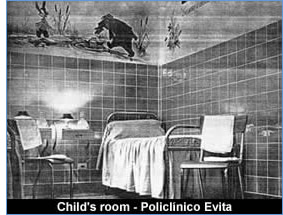 The
third floor was reserved for pre or post operative patients. A special
room for children, cheerful and spacious, was decorated with all the familiar
fairy tale figures. Social workers had their offices on this floor and
drew up a case study of each patient; their goal was to work with each
family unit and facilitate the practice of preventive medicine. The
third floor was reserved for pre or post operative patients. A special
room for children, cheerful and spacious, was decorated with all the familiar
fairy tale figures. Social workers had their offices on this floor and
drew up a case study of each patient; their goal was to work with each
family unit and facilitate the practice of preventive medicine.
The fourth floor was for gynecology, obstetrics, neonatology and pediatrics.
Nurses worked especially with first-time mothers.
The four operating theaters were on the fifth floor and two of them were
quite large so as to accommodate observers.
A small wing only one story high separated from the main complex housed
the morgue with autopsy rooms and a refrigeration room.
Another wing housed the outpatient clinics for pediatrics, gynecology,
obstetrics, dietetics, orthopedics, dermatology and general medicine.
The Policlínico Presidente Perón specialized in pneumology,
hematology and orthopedics, employing 1,500 people, 218 of which were
doctors and 491 of which were nurses; it also employed 32 kitchen workers,
as well as carpenters, plumbers, electricians, gardeners, and assorted
administrators. The Policlínico contracted outside employees such
as teachers (so the children would not fall behind in their schoolwork)
and home health care workers to assist in their homes those patients who
were either chronically ill or who could recover at home under medical
supervision.
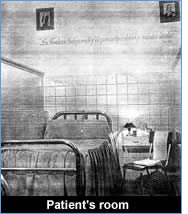 Evita
wanted to see for herself that her high standards were being met and was
known to visit the Fundación’s works at night and unexpectedly. Evita
wanted to see for herself that her high standards were being met and was
known to visit the Fundación’s works at night and unexpectedly.
Néstor Ferioli interviewed Lala García Marín, a friend
of Evita’s who was in charge of a pharmacy open around the clock.
García Marín told him how Evita had appeared at the pharmacy
at one o’clock in the morning and asked García Marín
to accompany her to the Policlínico Presidente Perón. Distressed
at reports that the doctors in the emergency room were not attending the
patients according to hospital regulations, Evita decided to investigate.
She was dressed in slacks, and a vest, her hair loose around her shoulders,
tinted glasses hiding her eyes. An attendant told them they would have
to wait and Evita sat down obediently. They waited. No doctors appeared.
Evita sent Lala to ask if they would have to wait much longer for a doctor.
She was told to wait. The two women waited some more.
Evita told Lala, “Go ahead. Try again.”
Lala tried again. “Will the doctor be much longer?”
The attendant answered, “Here you have to wait. It’s not a
matter of arriving and being seen immediately.”
They waited a while longer. Suddenly Evita jumped up, took off her glasses
and told the attendant, “Get me the doctor in charge of the emergency
room - immediately!”
The attendant asked, “And who wants to see him?”
“Eva Perón!”
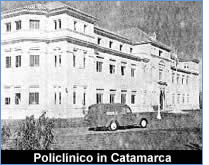 The
doctors came running in, fastening their smocks, sleep written all over
their faces. The
doctors came running in, fastening their smocks, sleep written all over
their faces.
Evita asked for the hospital’s Book of Rules, where all infractions
are noted, and began walking through the wards. She gently woke up and
interviewed every third or fourth patient. “How are you being treated?
Were you given the medicine you were supposed to have? Was the analysis
done?”
 Of course, to the patients it all seemed like a dream. As soon as they
woke up enough to realize they really were talking to Evita, they began
to ask her for things for their children or grandchildren. Of course, to the patients it all seemed like a dream. As soon as they
woke up enough to realize they really were talking to Evita, they began
to ask her for things for their children or grandchildren.
One can imagine the changes that occured in the administration as word
spread that Evita ran a tight ship.
In 1951, the Policlínico Presidente Perón sent a Hospital
Train throughout Argentina. Equipped with operating and a delivery rooms,
it offered free medical attention, vaccinations, x-rays and medicine to
all who needed care.
The three policlíncos located in the Province of Buenos Aires,
Presidente Perón in Avellaneda , Eva Perón in Lanús
and Evita in San Martín, were considered triplets because their
layout and services were almost identical; they provided a wider range
of services than the thirteen other regional policlínicos. In addition
to the policlínicos, the Fundación constructed specialized
hospitals such as the Burn Institute in Buenos Aires, the Infectious Diseases
Hospital in Haedo, the Thorax 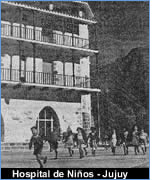 Surgery
Hospital in Ramos Mejía, and the 22 de Agosto Policlínico
in Ezeiza. Surgery
Hospital in Ramos Mejía, and the 22 de Agosto Policlínico
in Ezeiza.
High in the mountains of Jujuy nestled one of the crown jewels of the
Fundación’s hospital system, a combination hospital / hogar
escuela (for hogar escuela, see Education, Hogares Escuelas, this website)
designed to help children with kidney, rheumatic fever or nervous system
problems. 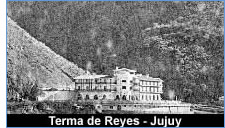 Located
in Terma de Reyes close to the capital city of Jujuy, the hospital had
a capacity for 144 sick children. A large swimming pool and smaller baths
were filled with thermal mineral waters from the Andes mountains. After
the 1955 military coup d’etat, the children were evicted and the
hospital turned into a casino and a hotel for military personnel and their
families. Located
in Terma de Reyes close to the capital city of Jujuy, the hospital had
a capacity for 144 sick children. A large swimming pool and smaller baths
were filled with thermal mineral waters from the Andes mountains. After
the 1955 military coup d’etat, the children were evicted and the
hospital turned into a casino and a hotel for military personnel and their
families.
In Buenos Aires, the Fundación almost completed what would have
been the largest children’s hospital in Latin America. Only finishing
touches were needed (adding plumbing fixtures, etc.) In September of 1955,
when the military took over Argentina, General Aramburu ordered a halt
to the construction. The building was totally abandoned and became a refuge
for derelicts and criminals (sometimes dead bodies were tossed over the
wall into the school yard next door).
In 1976,
at the beginning of the Dirty War (during which 30,000 Argentine men,
women and children were “disappeared” by their own government),
in an act heavy with symbolism, General Videla’s regime turned the
almost - completed children’s hospital into a concentration camp
for the victims of the military regime.
Bibliography
Ferioli,
Néstor. La Fundación Eva Perón / 2. Buenos
Aires:Centro Editor de América Latina, 1990.
Fraser, Nicholas
& Marysa Navarro. Evita: The Real Life of Eva Perón.
New York: W.W. Norton & Company, 1996.
Ortiz, Alicia
Dujovne. Eva Perón. New York: St. Martin’s Press,
1996.
Fundación
Eva Perón. Eva Perón and Her Social Work. Buenos
Aires: Subsecretaria de Informaciones, 1950.
Escuela
de Enfermeras. Buenos Aires: Subsecretaria de Informaciones, 1951.
La Nación
Argentina: Justa, Libre, Soberana. Buenos Aires: Ediciones Peuser,
1950.
|
 |
  by
Dolane Larson by
Dolane Larson |
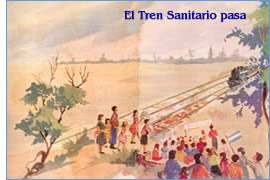 Universal and affordable health care had long been a goal of Peron and
Evita. Universal and affordable health care had long been a goal of Peron and
Evita.
During the early years of his presidency, Peron had voiced his concern
for those who could not afford adequate medical care: “The state
must offer integral medical assistance to those who earn least. If I am
taken ill and I am a millionaire, I will bring specialists from all over
the world, ...and I would have a good possibility of saving my life. The
poor, on the other hand, have no chance at all of doing that. ... [In]
the interior of the country, ... 50% of those who die do so without any
medical attention.
“In the country of meat, in the country of bread, in the country
which has 300 days of sunlight a year, in the country where we have everything
... the lifespan is ...ten years less than in the U.S. Organizing public
health care can prolong our lives by an average of ten to twenty years.”
La Nacion Argentina: Justa, Libre, Soberana
Ed. Peuser, Buenos Aires, 1950, pg. 321
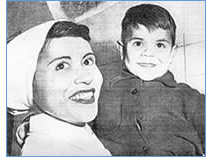 In
1951, with the idea that if not all descamisados could go to the policlinicos,
then a policlinico should go to them, the Fundacion inaugurated a new
style of medical care: el Tren Sanitario, the “Health Care Train.”
Sent by the Policlínico Presidente Perón, the train consisted
of twelve cars and carried forty-six health care specialists throughout
the country; in four months it chugged its way throughout Argentina. One
car was set up as a theater which showed movies to educate the public
about basic hygiene and preventive medicine. Equipped with living and
dining quarters for its personnel, its own generator, pharmacy, laboratories,
x-ray rooms, and a waiting room, an operating theater and a delivery room,
the Health Care Train offered medical and dental check-ups, x-rays, vaccinations,
medicine, OBGYN services: all free. In
1951, with the idea that if not all descamisados could go to the policlinicos,
then a policlinico should go to them, the Fundacion inaugurated a new
style of medical care: el Tren Sanitario, the “Health Care Train.”
Sent by the Policlínico Presidente Perón, the train consisted
of twelve cars and carried forty-six health care specialists throughout
the country; in four months it chugged its way throughout Argentina. One
car was set up as a theater which showed movies to educate the public
about basic hygiene and preventive medicine. Equipped with living and
dining quarters for its personnel, its own generator, pharmacy, laboratories,
x-ray rooms, and a waiting room, an operating theater and a delivery room,
the Health Care Train offered medical and dental check-ups, x-rays, vaccinations,
medicine, OBGYN services: all free.
One of Evita’s greatest accomplishments was surely that of universal
health care. She herself was operated on at the Policlínico Presidente
Perón; at the time of her death, for the first time in Argentine
history, “there was no inequality in Argentine health care.”
[Navarro, pg. 131] How many nations have achieved that goal in just seven
years... or even tried to?
Bibliography
Ferioli,
Néstor. La Fundación Eva Perón / 2. Buenos
Aires:Centro Editor de América Latina, 1990.
Fraser, Nicholas
& Marysa Navarro. Evita: The Real Life of Eva Perón.
New York: W.W. Norton & Company, 1996.
Ortiz, Alicia
Dujovne. Eva Perón. New York: St. Martin’s Press,
1996.
Fundación
Eva Perón. Eva Perón and Her Social Work. Buenos
Aires: Subsecretaria de Informaciones, 1950.
La Nación
Argentina: Justa, Libre, Soberana. Buenos Aires: Ediciones Peuser,
1950.
Mundo
Peronista . 1951. |
|
